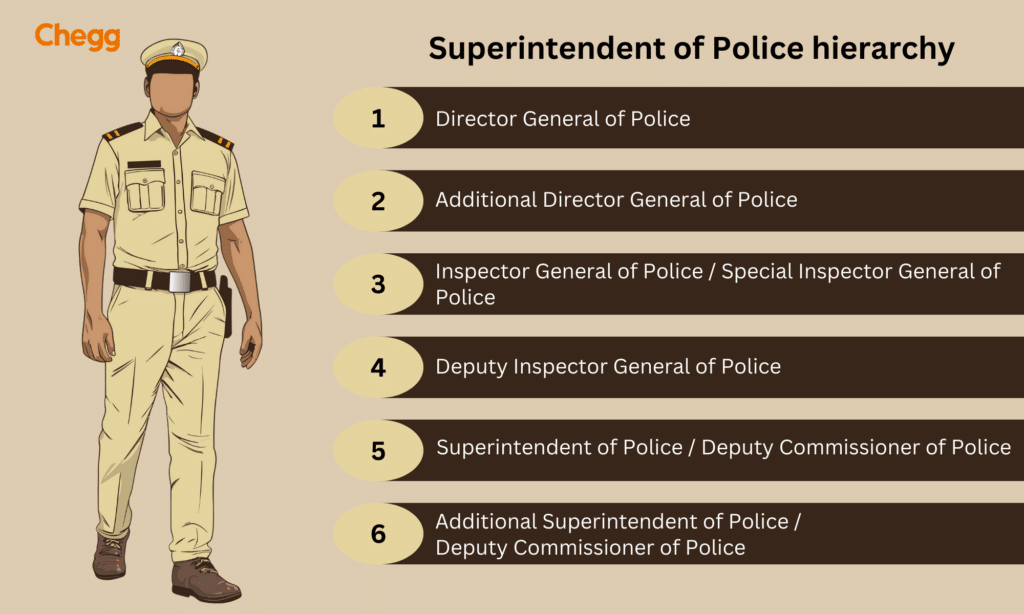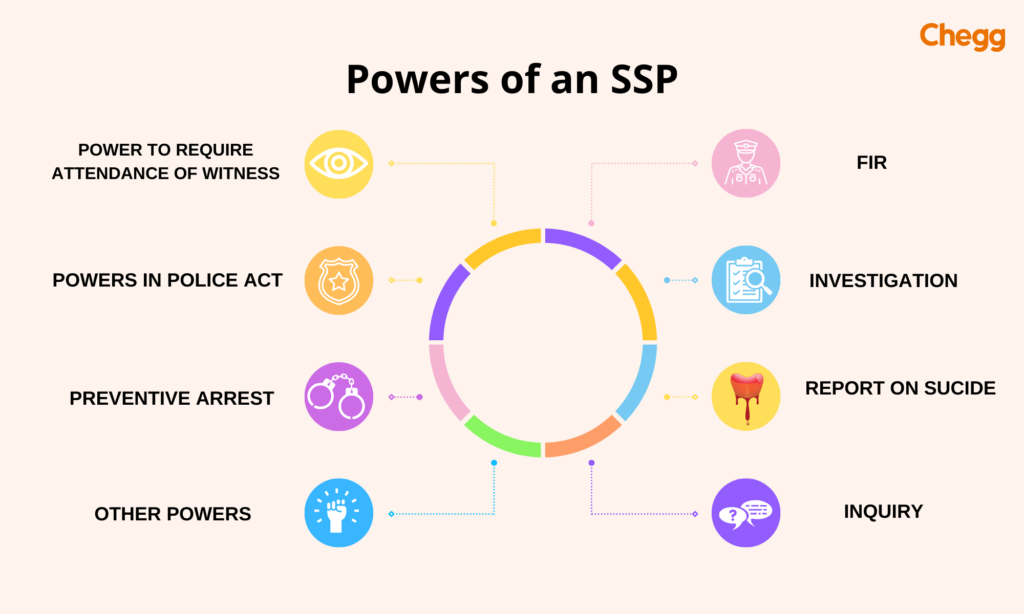Home » Full Forms » SSP Full Form: The Skills and Expertise of Senior Superintendent of Police
SSP Full Form: The Skills and Expertise of Senior Superintendent of Police

Table of Contents
SSP full form
In India, SSP full form is Senior Superintendent of Police. This position plays a crucial role in managing police affairs in a district or urban area. Respecting law and order, reducing crime, and maintaining the public’s safety and security are important responsibilities given to Senior Superintendent of Police.
The Senior Superintendent of Police position was first established in India during the colonial period. During British rule, this position aimed to establish an organized and efficient police force. In the post-independence era, India retained and restructured its police system, wherein the role of SSPs evolved to meet the diverse and unique challenges of the nation. They have made their responsibilities from regular police by adopting developments in technology and changes in culture. Today’s SSPs actively connect with communities and establish positive public relations while maintaining law and order for the good of the country.
SSP Meaning
The SSP is a senior police officer whose responsibility is to manage law enforcement activities in a town or city. So, SSP is within the police organization, they have ‘IPS’ below a star and an Ashoka emblem on their. Senior Superintendent of Police manages the bigger, more significant districts in India, whereas an SP manages the smaller, less significant districts.
The development of SSPs in India is from the British colonial period when they developed a structured police system. Since India’s police forces were reorganized after independence, SPs have played an important part in maintaining public safety and the rule of law. To improve their performance and better serve society, they have changed their plan of action according to time, practicing modern tools and community-focused activities.
Superintendent of Police: Rank and Hierarchy
In the Indian police force, the Superintendent of Police (SP) has a significant position. They are in charge of keeping the neighborhood or city in order. They manage the work of police, maintain law and order, and protect public safety. Depending on the state’s police organization, SPs can speak to the Deputy Inspector General or the Inspector General.
When compared to other police positions, the Superintendent of Police is placed above the Deputy Inspector General and below the Deputy Superintendent of Police. Strong leadership and managing difficult difficulties in their district are required for the SP’s position. To maintain our neighborhoods calm and safe, they put in a lot of effort.

Powers and Authority of the Senior Superintendent of Police
Senior Superintendents of Police (SSPs) have vital powers to enforce laws and prevent crimes in their district. They lead investigations, ensuring a thorough examination of criminal incidents.
SSPs hold the authority to maintain public order, promoting a peaceful community. As leaders, they oversee multiple police stations, ensuring efficient law enforcement and safeguarding the well-being of the residents. Additionally, SSPs collaborate with various police units, mentor their team, and contribute to creating a secure and orderly neighborhood.
One of the major responsibilities of the SSP is to maintain public order. They make sure that people live peacefully, without conflicts. They put a lot of effort into protecting everyone and ensuring that justice is delivered when it is called for, and they are crucial to the area’s safety and security.
SSPs are like police force leaders. They handle and manage several police stations and divisions. They ensure that police obey the law and take every measure necessary to safeguard the people.

SSP’s Role in Maintaining Law and Order
SSPs act to put an end to unsafe gatherings or large conflicts. They operate with their teams to ensure everyone’s safety and diffuse the situation calmly. SSPs function as communicators during rallies and protests. They ensure that individuals may express their opinions in peace and without risk of harm to themselves and others.
SSP role is that they identify places that need extra protection, like important buildings or events. They use security measures to keep those areas safe and respond quickly in emergencies.
When some protests or gatherings turn violent and dangerous they maintain law and order, making our neighborhoods safe places to live. They also engage to restore order and divide their squad in an orderly manner to ensure everyone’s safety. SSPs are dedicated leaders who put in a lot of effort to maintain peace and order, safeguard the neighborhood, and improve the lives of others.
Skills and Qualities of an Effective Superintendent of Police
SP are capable leaders who can point the team on the right path. To ensure that law and order are maintained in the community and to keep people safe, they make tough choices. SPs need to communicate well with their team and the public. They listen to people’s concerns and address them with empathy. Clear communication helps them work together and build trust with the community.
During difficult situations, SPs need to stay calm and think quickly. They should be skilled at managing crises and finding solutions to complex problems. Under pressure, they must be able to make reasonable decisions. A Superintendent of Police needs to effectively manage their staff, engage with the community, and safeguard everyone’s well-being and safety by having these qualities and skills.
How to Become SSP in Police
To become a Senior Superintendent of Police (SSP), start by completing high school and then pursue a bachelor’s degree from a recognized college. It’s preferable to choose a Bachelor of Arts (BA) degree in a social science field such as criminology, psychology, political science, public administration, or sociology. Gain practical experience in the field and put in hard work.
Through dedication and excellent performance, you can progress through different roles, starting as an inspector, then moving on to become a deputy superintendent, and ultimately achieving the position of SSP. In the Indian Police Service (IPS), an officer is promoted to the Selection Grade after 13 years of service, reaching the level of Senior Superintendent.
Engage in training programs to enhance your leadership, crisis management, and community involvement skills throughout your career. This will prepare you for the responsibilities of a Senior Superintendent of Police. As you work towards this role, you’ll have a positive impact on the community. Keep striving for excellence and continue your learning journey.
SSC Exam Pattern
To become an SSP, or Senior Superintendent of Police, in India, you typically need to follow a career path in the Indian Police Service (IPS). The IPS is a prestigious and competitive civil service that requires a commitment to law enforcement and public service. Here’s a general outline of how to become an SSP:
To pass the test, you need to complete three ranges:
Main Examination: This exam consists of nine papers in total, and students who pass it are invited to an interview.
Preliminary Examination: Exam papers are limited to what the student must pass; the exam’s results are no longer transferred to the main exam.
Interview: Since the UPSC verifies the outcome after the interview, the interview serves as the final level of the examination. The interview consists of two hundred marks, and college students are required to respond to questions about their country, politics, intellectual capacity, and areas of interest.
SSP Earnings
When it comes to the SSP’s earnings, the initial earnings range from ₹ 118,000 to ₹ 210000. In addition, the government provides some other benefits and facilities, such as a shipping facility, house, car, electricity, and a fitness center.
Conclusion
SSP full form the Senior Superintendent of Police, is a key figure in the police department who is in charge of maintaining peace and order in our communities. They are there to protect the public’s safety and security and work tirelessly to control riots, handle demonstrations peacefully, protect us during civil unrest, and manage police stations, making sure everything runs smoothly.
Learn about some other full forms:
| RTI Full Form | CISF Full Form |
| SHO Full Form | DCP Full Form |
| PCC Full Form | NSG Full Form |
| IAS Full Form | SDM Full Form |
| EWS Full Form | FIR Full Form |
SSP Full Form : FAQs
SSP full form is “Senior Superintendent of Police.
An SSP is a senior officer in charge of managing law enforcement actions within a district or city region.
SSPs work with their team to control riots, handle demonstrations, and maintain peace in the community.
No, becoming an SSP requires gaining experience through entry-level positions like police officers and climbing the ranks.
A successful SSP requires strong leadership, decision-making, communication, and crisis management abilities.
When it comes to earnings of Senior Superintendent of Police (SSP full form) the starting range from ₹ 118000 to ₹ 210000.
Deputy Commissioner of Police (DCP) has more powers than Senior Superintendent of Police (SSP full form)
Got a question on this topic?